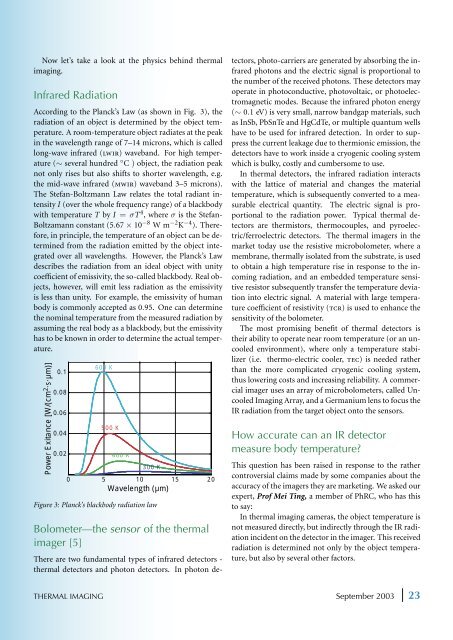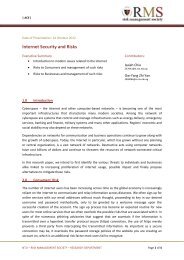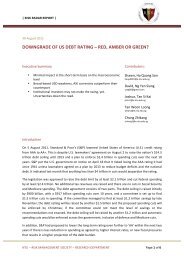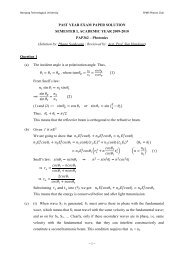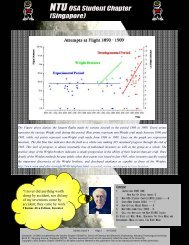PhRC NEWSLETTER PHOTONICS'La - Nanyang Technological ...
PhRC NEWSLETTER PHOTONICS'La - Nanyang Technological ...
PhRC NEWSLETTER PHOTONICS'La - Nanyang Technological ...
Create successful ePaper yourself
Turn your PDF publications into a flip-book with our unique Google optimized e-Paper software.
Now let’s take a look at the physics behind thermal<br />
imaging.<br />
Infrared Radiation<br />
According to the Planck’s Law (as shown in Fig. 3), the<br />
radiation of an object is determined by the object temperature.<br />
A room-temperature object radiates at the peak<br />
in the wavelength range of 7–14 microns, which is called<br />
long-wave infrared (lwir) waveband. For high temperature<br />
(∼ several hundred ◦ C ) object, the radiation peak<br />
not only rises but also shifts to shorter wavelength, e.g.<br />
the mid-wave infrared (mwir) waveband 3–5 microns).<br />
The Stefan-Boltzmann Law relates the total radiant intensity<br />
I (over the whole frequency range) of a blackbody<br />
with temperature T by I = σT 4 ,whereσ is the Stefan-<br />
Boltzamann constant (5.67 × 10 −8 Wm −2 K −4 ). Therefore,<br />
in principle, the temperature of an object can be determined<br />
from the radiation emitted by the object integrated<br />
over all wavelengths. However, the Planck’s Law<br />
describes the radiation from an ideal object with unity<br />
coefficient of emissivity, the so-called blackbody. Real objects,<br />
however, will emit less radiation as the emissivity<br />
is less than unity. For example, the emissivity of human<br />
body is commonly accepted as 0.95. One can determine<br />
the nominal temperature from the measured radiation by<br />
assuming the real body as a blackbody, but the emissivity<br />
has to be known in order to determine the actual temperature.<br />
Power Exitance [W/(cm 2 ·s·µm)]<br />
0.1<br />
0.08<br />
0.06<br />
0.04<br />
0.02<br />
600 K<br />
500 K<br />
400 K<br />
300 K<br />
0 5 10 15 20<br />
Wavelength (µm)<br />
Figure 3: Planck’s blackbody radiation law<br />
Bolometer—the sensor of the thermal<br />
imager [5]<br />
There are two fundamental types of infrared detectors -<br />
thermal detectors and photon detectors. In photon de-<br />
tectors, photo-carriers are generated by absorbing the infrared<br />
photons and the electric signal is proportional to<br />
the number of the received photons. These detectors may<br />
operate in photoconductive, photovoltaic, or photoelectromagnetic<br />
modes. Because the infrared photon energy<br />
(∼ 0.1 eV) is very small, narrow bandgap materials, such<br />
as InSb, PbSnTe and HgCdTe, or multiple quantum wells<br />
have to be used for infrared detection. In order to suppress<br />
the current leakage due to thermionic emission, the<br />
detectors have to work inside a cryogenic cooling system<br />
which is bulky, costly and cumbersome to use.<br />
In thermal detectors, the infrared radiation interacts<br />
with the lattice of material and changes the material<br />
temperature, which is subsequently converted to a measurable<br />
electrical quantity. The electric signal is proportional<br />
to the radiation power. Typical thermal detectors<br />
are thermistors, thermocouples, and pyroelectric/ferroelectric<br />
detectors. The thermal imagers in the<br />
market today use the resistive microbolometer, where a<br />
membrane, thermally isolated from the substrate, is used<br />
to obtain a high temperature rise in response to the incoming<br />
radiation, and an embedded temperature sensitive<br />
resistor subsequently transfer the temperature deviation<br />
into electric signal. A material with large temperature<br />
coefficient of resistivity (tcr) is used to enhance the<br />
sensitivity of the bolometer.<br />
The most promising benefit of thermal detectors is<br />
their ability to operate near room temperature (or an uncooled<br />
environment), where only a temperature stabilizer<br />
(i.e. thermo-electric cooler, tec) is needed rather<br />
than the more complicated cryogenic cooling system,<br />
thus lowering costs and increasing reliability. A commercial<br />
imager uses an array of microbolometers, called Uncooled<br />
Imaging Array, and a Germanium lens to focus the<br />
IR radiation from the target object onto the sensors.<br />
How accurate can an IR detector<br />
measure body temperature?<br />
This question has been raised in response to the rather<br />
controversial claims made by some companies about the<br />
accuracy of the imagers they are marketing. We asked our<br />
expert, Prof Mei Ting, a member of <strong>PhRC</strong>, who has this<br />
to say:<br />
In thermal imaging cameras, the object temperature is<br />
not measured directly, but indirectly through the IR radiation<br />
incident on the detector in the imager. This received<br />
radiation is determined not only by the object temperature,<br />
but also by several other factors.<br />
THERMAL IMAGING September 2003 23


